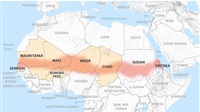Brotherhood cancer spreads throughout Europe

There are many manifestations of the Brotherhood incursion
into European societies, especially after the terrorist group demonstrated its
ability to penetrate these societies through social and humanitarian
organizations and mosques that were established with the aim of ensuring
control and exploiting them to achieve an intellectual conquest of these
societies and to influence the course of internal conditions in these countries
or to influence their external decision-making in a way that preserves the
group’s interests.
Europe has been exposed to a large influx of refugees from
the Middle East conflict regions, mostly Muslim, which prompted this file to be
exploited in the growing relationship between these groups and European
governments.
New type of exploitation
For example, the Brotherhood has attempted to provide the
needs for the waves of migrants to continue in these countries so as to control
these Muslim communities to put pressure on European governments to accept the de
facto situation. This was the nucleus of influencing European citizens and
mobilizing them to join these organizations, in what is known as civil jihad
within Western societies.
Impact weapons
Extremist groups have succeeded in penetrating into European
societies through charitable organizations, taking advantage of European laws
that allow pluralism. But in light of the increasing rates of refugee influx
and illegal immigration, the activity of these groups increased through these
organizations, and their level of interaction with European citizens increased,
allowing them to spread their extremist ideas through advertisements,
fundraising and other tools, which resulted in an increase in the numbers of
those joining these groups. This led to terrorist attacks being carried out in
European countries, including lone wolf operations, stabbings, and vehicular
manslaughter, as well as some individuals going to fight in the hotbeds of
various conflicts in the Middle East.
Brotherhood dangers
The European Center for Counterterrorism and Intelligence
Studies published a study entitled “The Risks of the Muslim Brotherhood in
Building Parallel Societies in Europe”, in which it touched on the nature of
the Brotherhood’s activity in European societies, its tools of influence, and
its control over the central Islamic councils through political pressure on
European governments, as they have influence on Muslim communities.
There are many forms of Islamic councils in many European
countries, including the European Council for Fatwa and Research (ECFR),
founded in 1997 by Brotherhood Mufti Youssef al-Qaradawi with Qatari funds, in
addition to the Central Council of Muslims in Germany (ZMD), which was founded
in 1993 and headed by Aiman Mazyek. The ZMD includes 19 Islamic organizations
and about 300 affiliated mosques, as well as Islamic schools. The Islamic
Center in Munich is the central organization of the Brotherhood in Germany and
focuses on social and advocacy services to attract Muslims.
British network
The Muslim Council of Britain is the largest Islamic
institution in the country, with more than 500 Islamic bodies. It is unofficially
linked with the Brotherhood, in addition to the Union of Islamic Communities in
Italy (UCOII), which is involved in close cooperation with the Brotherhood in
Qatar, and the Swedish Islamic Council, which falls under the umbrella of the
Muslim League, which has multiple arms in Europe. In Denmark, Qatar established
the Islamic Council to finance extremist currents and the remnants of the
Brotherhood fleeing from Arab countries, fundraising to collect funds and
distribute them to leaders of malicious groups, organizations and currents
within Europe.
Social media
Most terrorist groups have taken advantage of social media
platforms to expand their reach and recruit new elements, attracting those who
share the same ideology, who then become media trumpets to publish everything
related to extremist operations.
According to Western studies, more than 80% of youth
recruitment operations among terrorist groups are carried out through social
media, including Facebook, Twitter, YouTube and other sites, which helps them
greatly in implementing their plans by including the largest possible number of
members.







